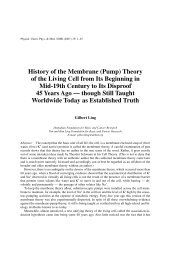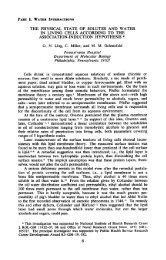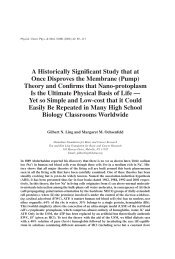Primary Thermosensory Events in Cells - Springer
Primary Thermosensory Events in Cells - Springer
Primary Thermosensory Events in Cells - Springer
Create successful ePaper yourself
Turn your PDF publications into a flip-book with our unique Google optimized e-Paper software.
25 <strong>Primary</strong> <strong>Thermosensory</strong> <strong>Events</strong> <strong>in</strong> <strong>Cells</strong> 463<br />
molecules is only the size and the organization of the “excit<strong>in</strong>g” agents – a lot<br />
of non-coord<strong>in</strong>ated events (thermal stimuli) versus a net stretch (mechanical stimuli).<br />
Therefore, nor surpris<strong>in</strong>gly, many members of thermosens<strong>in</strong>g TRPV family<br />
are also known as osmo- and mechano-sensors. Because mechanical stimuli are<br />
omnipresent, mechanosensation could represent one of the oldest sensory transduction<br />
processes that have evolved <strong>in</strong> liv<strong>in</strong>g organisms. Similarly to thermal sensors,<br />
what exactly makes these channels respondent to membrane tension is unclear. The<br />
answer will not be simple because both thermal- and mechano-sensors are very<br />
diverse [84, 85]. However, there are <strong>in</strong>terest<strong>in</strong>g parallels <strong>in</strong> structural composition of<br />
different classes of known temperature-sensory prote<strong>in</strong>s, pend<strong>in</strong>g comprehension.<br />
Despite significant evolutionary distances and apparent differences of primary<br />
structure, all temperature-sensitive prote<strong>in</strong>s known so far display some remarkable<br />
similarities <strong>in</strong> their tertiary/quaternary structure. The ability of a big prote<strong>in</strong><br />
TlpA responsible <strong>in</strong> S. typhimurium for temperature regulation of transcription<br />
undoubtedly resides <strong>in</strong> its peculiar structural design. Two-thirds of the C-term<strong>in</strong>al<br />
portion of TlpA is folded <strong>in</strong> an alpha-helical-coiled-coil structure that constitutes<br />
an oligomerization doma<strong>in</strong>. The sensory capacity is consealed <strong>in</strong> this coiled-coil<br />
structure, which illustrates the means of sens<strong>in</strong>g temperature through changes <strong>in</strong><br />
prote<strong>in</strong> conformation. As the temperature <strong>in</strong>creases, the proportion of DNA-b<strong>in</strong>d<strong>in</strong>g<br />
oligomers decreases, lead<strong>in</strong>g to a de-repression of the target gene. At moderate temperatures,<br />
the concentration of TlpA <strong>in</strong>creases, shift<strong>in</strong>g the balance to the formation<br />
of DNA-b<strong>in</strong>d<strong>in</strong>g oligomers and, <strong>in</strong> part, restor<strong>in</strong>g the repression potential of TlpA.<br />
Thus, TlpA undergoes a reversible conformational shift <strong>in</strong> response to temperature<br />
alteration, lead<strong>in</strong>g to an alteration <strong>in</strong> the oligomeric structure [48].<br />
The coiled-coil prote<strong>in</strong> structure is a very versatile and a flexible motif <strong>in</strong> mediat<strong>in</strong>g<br />
prote<strong>in</strong>-prote<strong>in</strong> <strong>in</strong>teractions. In vertebrates, the thermosensitive elements of<br />
transcriptional mechanism typically conta<strong>in</strong> such coiled-coil fold<strong>in</strong>g motifs, like<br />
those <strong>in</strong> leuc<strong>in</strong>e zipper family.<br />
TRPV channel subunits have a common topology of six transmembrane segments<br />
(S1–S6) with a pore region between the fifth and sixth segment, and<br />
cytoplasmic N- and C-term<strong>in</strong>i. In these thermo-TRP channels, it has been proposed<br />
that the structural rearrangement leads to a change <strong>in</strong> tension on the helical l<strong>in</strong>ker<br />
connect<strong>in</strong>g the C-term<strong>in</strong>al doma<strong>in</strong>s with S6 segment. This tension on the l<strong>in</strong>ker provides<br />
the energy necessary to move the S6 <strong>in</strong>ner helix to the open conformation<br />
[58, 59]. Indeed, partial deletions performed <strong>in</strong> the C-term<strong>in</strong>al doma<strong>in</strong> of TRPV1<br />
resulted <strong>in</strong> functional channels with attenuated heat sensitivity, whereas truncation<br />
of the whole TRPV1 C-term<strong>in</strong>al doma<strong>in</strong> completely h<strong>in</strong>dered channel expression<br />
[57]. Another possibility could be that temperature affects the <strong>in</strong>teraction between a<br />
particular portion of the proximal C-term<strong>in</strong>al and some other region of the channel,<br />
probably an <strong>in</strong>tracellular loop. F<strong>in</strong>ally, it might be that <strong>in</strong>dependent arrangements<br />
<strong>in</strong>duced by temperature on C-term<strong>in</strong>al doma<strong>in</strong>s directly promote gate open<strong>in</strong>g [57].<br />
Bernd Nilius’ group <strong>in</strong> their study on the voltage dependence of TRP channel<br />
gat<strong>in</strong>g by temperature po<strong>in</strong>ted out that the small gat<strong>in</strong>g charge of TRP channels<br />
compared to that of classical voltage-gated channels could lie at the basis of the large<br />
shifts of their voltage-dependent activation curves, and may be essential for their







